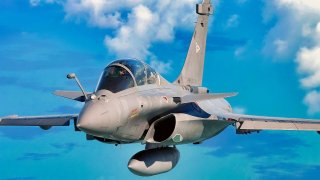Dassault Rafale: The Powerhouse Fighter Not Named NGAD or F-22 Raptor
The Dassault Rafale, France’s multirole fighter, boasts a delta wing and canard configuration similar to the Eurofighter Typhoon. Agile and versatile, the Rafale handles a range of missions, from air superiority to ground support. Its 4.5-generation designation stems from advanced software upgrades, providing modern combat capabilities without full stealth.
What You Need to Know: The Dassault Rafale, France’s multirole fighter, boasts a delta wing and canard configuration similar to the Eurofighter Typhoon. Agile and versatile, the Rafale handles a range of missions, from air superiority to ground support. Its 4.5-generation designation stems from advanced software upgrades, providing modern combat capabilities without full stealth.

-With Snecma M88 engines enabling supercruise, the Rafale combines speed and efficiency.
-Exported to nations including India, Qatar, and Greece, it continues to attract global interest. The Rafale’s blend of agility, lower radar cross-section, and advanced avionics ensures it will remain relevant in many -air forces worldwide.
Dassault Rafale: France’s Agile Multirole Fighter Taking the World by Storm
In a recent piece, I wrote about the Eurofighter Typhoon and its distinct canard delta wing. I should have mentioned that the Eurofighter is not alone among NATO fighters in featuring such a wing. Across the Channel, the French have their own triangular fighter, the Dassault Rafale. The two aircraft cut a similar silhouette, and from most angles neither is especially attractive.
But seen head-on, the Rafale is uniquely gorgeous.
Introducing the Rafale
Rafale is French for gust of wind. While the name may sound odd to the non-French-speakers among us, it makes perfect sense for this multirole fourth-generation aircraft. Billed as a jack of all trades, the Rafale provides the French with an aircraft that can perform anything from air superiority missions to ground support and interdiction.
Dassault bills the Rafale as a 4.5-generation fighter, a designation most commonly applied to fourth-generation aircraft that have received software upgrades. These jets have the brains of a fifth-generation fighter, even while lacking the thrust vectoring or low radar cross section.
The Rafale is quite agile, as delta winged aircraft tend to be. The Rafale can handle anything from -3.6 to 9G and can even push to 11G in an emergency. Like many fourth-generation aircraft, the Rafale is inherently unstable and requires constant input from a digital fly-by-wire system to maintain control of the aircraft. The benefit of instability, of course, is maneuverability.
While the Rafale is not a stealth aircraft, the airframe was designed to keep the radar cross section relatively low while emitting a reduced infrared signature. To achieve the Rafale’s low radar cross section, the tail fin was reduced while the engine’s air inlets were tucked beneath the wings. Composite materials were used, and the trailing edges of the wings and canards were assembled with serrated patterns. Other features relating to the Rafale’s low radar cross section have not been disclosed to the public.
For power, the Rafale relies on two Snecma M88 engines. Each M88 offers 11,000 pounds of force dry and 17,000 pounds of thrust with afterburners engaged. The M88 has supercruise capability, too, which allows the Rafale to intercept at supersonic speeds without using afterburners, which are highly fuel-intensive and can deplete the fuel necessary to engage with an adversary.
The Rafale has been exported around the world. Clients include Qatar, India, Greece, Croatia, and Egypt. Future operators include Indonesia, Serbia, and the United Arab Emirates. Still, more countries are hoping to procure the reliable Rafale. Bangladesh, Colombia, Iraq, Malaysia, and Peru are understood to be working on Rafale procurements.
We can expect the Rafale to be around for a while, especially as fourth-generation technologies diffuse into third-world air forces.

About the Author: Harrison Kass
Harrison Kass is a defense and national security writer with over 1,000 total pieces on issues involving global affairs. An attorney, pilot, guitarist, and minor pro hockey player, Harrison joined the US Air Force as a Pilot Trainee but was medically discharged. Harrison holds a BA from Lake Forest College, a JD from the University of Oregon, and an MA from New York University. Harrison listens to Dokken.
Image Credit: Creative Commons.


